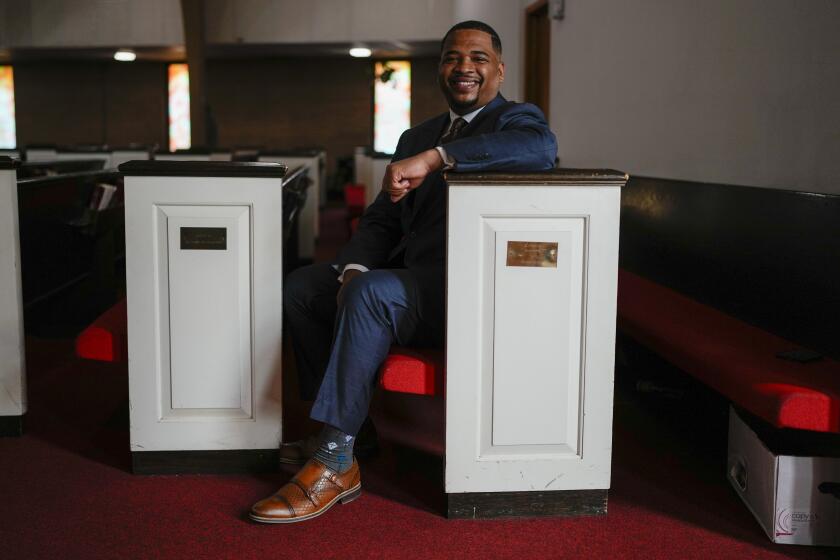‘Dance of Death’ would revive budget process
Seven weeks past their constitutional deadline for passing a state budget, legislators still are stumbling around. Why? Because they haven’t yet done the “Dance of Death.”
That’s the annual ritual in which one budget proposal after another is ceremoniously sacrificed on chamber floors until there’s agreement on a single survivor.
“Everybody dances around the fire. They throw stuff at us. We throw stuff at them. Everybody falls over dead, and we start all over again,” is how a senior legislative staffer described it to me 15 years ago.
That staffer -- it now can be told -- was Phil Perry, then communications director for Assembly Republican leader Jim Brulte of Rancho Cucamonga, and currently head of a political public relations firm. For years, he refused to be identified. “I could have gotten in trouble,” he says. But the statute of limitations long ago ran out, he figures.
Today’s legislators, Perry surmises, “have either forgotten the steps to the Dance of Death or they’re too scared to move.”
As a result, legislators this summer have yet to take a budget vote on either house floor -- or even in a full budget committee. A prematurely created bi-house conference committee did endorse a one-sided Democratic budget on a party-line vote, an exercise that resolved nothing. Few legislators even have been in town recently, mainly only the leaders.
In the past, Gov. Arnold Schwarzenegger has called the Dance of Death “part of the Kabuki.” But Perry thinks that’s giving the Legislature too much credit.
Kabuki -- classic Japanese song-and-dance drama -- “is a very precise process,” the former legislative aide notes. “There’s nothing precise about what goes on with any of these budget processes. There’s no plan. Whatever occurs to people is what they do.”
I used to poke fun at the death dance.
And it was derided inside the Capitol as “a drill” -- an exercise to maul the other party. Democrats would portray Republicans as obstructionists and insensitive kooks. Republicans would blast Democrats as socialist spending addicts.
But these nasty performances on the house floors were vital to eventual budget compromise.
Legislators, especially minority Republicans, were allowed to vent their emotions and record their positions. They could run a proposal up the vote tally board, have it shot down and still tell their constituents, “I tried.”
Sometimes they acted a little nutty -- one anti-abortion lawmaker used to adorn each member’s desk with a toy fetus. But they’d get it out of their systems.
In recent years, however, leaders have called off the dance. They considered it too ugly, too divisive and a waste of time. They’ve tried to cut to the chase: Don’t bother with budget committee votes. Just patch together a budget from subcommittee reports, bypass the chambers and send the paste-up directly to a bi-house conference committee.
In the current case, the conference committee produced a $146-billion budget with a nearly $10-billion tax increase -- a spending plan, $2 billion higher than the governor’s proposal, that has no Republican support. It hasn’t even been publicly debated beyond the six-member conference committee.
Such short-circuiting of the traditional legislative process is bound to misfire. A conference committee is designed to settle differences between the two houses after they’ve deliberated and voted. It’s not supposed to be a fast-track conduit for propelling a partisan bill directly from subcommittees to the Big Five negotiating table (the governor and four legislative leaders).
Currently, the two Democratic leaders -- Senate President Pro Tem Don Perata of Oakland and Assembly Speaker Karen Bass of Los Angeles -- assert that they don’t want to hold public floor fights while they’re in intense private negotiations with Republicans. They also don’t want to lean on vulnerable Democrats to vote for an unpopular tax increase until Republicans are willing to pitch in some support.
Assembly GOP leader Mike Villines of Clovis says a floor brawl “would have been good for us.” He uses a boxing analogy: “It’s like when everybody is missing punches. Someone just needs to grab and hold on. The referee comes in and says, ‘Let’s get going.’ ”
The referee should be the governor. But he was staying out of the ring until 10 days ago.
For weeks -- months -- practically everyone at the Capitol has known the compromise pieces necessary for an honestly balanced budget: Democrats must agree to budget “reform” (spending cap, rainy day fund) and a few more program cuts. The governor then must perform an acrobatic flip-flop and publicly advocate tax increases, providing political cover for some Republicans to vote for them, screaming.
Secretary of State Debra Bowen has set an Aug. 16 deadline for placing a budget reform measure on the November ballot. Such deadlines have a habit of slipping.
My prediction: It’ll all get done in time for Democrats to attend their historic national convention starting Aug. 25. That’s the main motivator.
My nomination for additional budget reform: Eliminate the ludicrous requirement of a two-thirds legislative vote for passage of a budget. Only two other states suffer the same straitjacket. California would have had a budget weeks ago if it could have been passed by a simple majority vote. The governor still would have the final say with his paring knife.
And require a return to the traditional legislative process: Committee votes. Floor votes. The “Dance of Death.”
It’s not exactly “Dancing With the Stars.” But it’s therapeutic for the performers.
--
More to Read
Get the L.A. Times Politics newsletter
Deeply reported insights into legislation, politics and policy from Sacramento, Washington and beyond. In your inbox three times per week.
You may occasionally receive promotional content from the Los Angeles Times.







